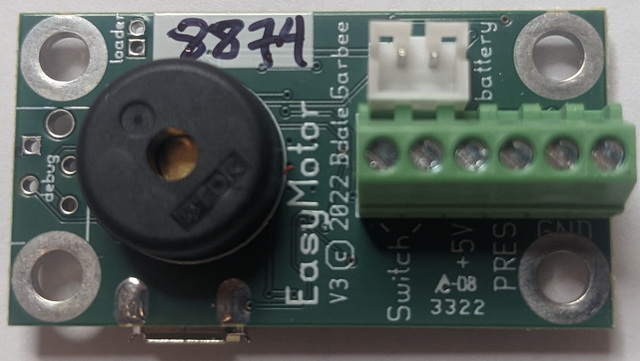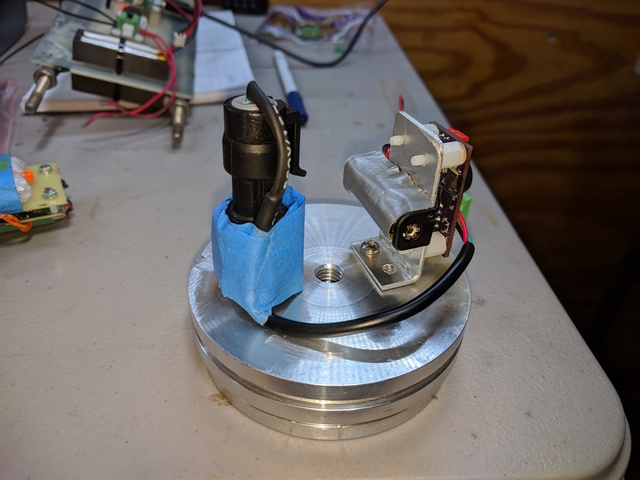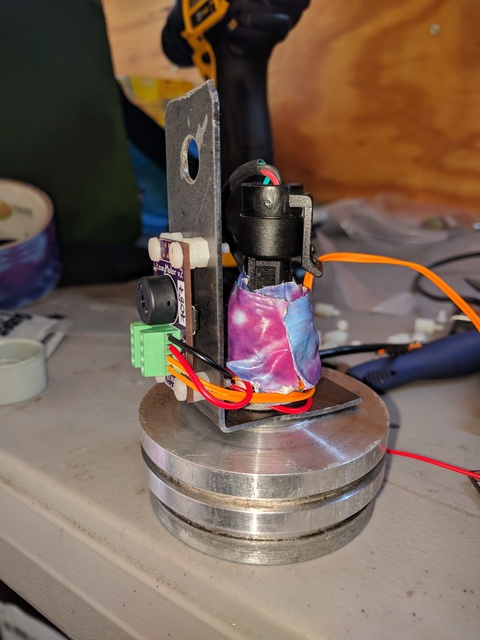EasyMotor
This board is designed for in-flight characterization of research rocket motors. It records chamber pressure and acceleration to an on-board flash memory chip, the contents of which can be downloaded after flight over USB.
EasyMotor version 3 is available from the Garbee and Garbee web store and from our distributors.
For the latest EasyMotor firmware and related ground station software, please visit the AltOS page on this site. EasyMotor version 3.0 requires AltOS version 1.9.12 or later.
This is what a production v3 board looks like:
Features
User View
- Data logger storing motor chamber pressure and acceleration
- works with inexpensive 5V analog output pressure sensors
- USB for configuration, data recovery, and battery charging
- Designed for use with a single-cell LiPo battery
- 1.5 x 0.8 inch board
Developer View
Hardware Features
- NXP LPC11U14 System-on-Chip
- ARM Cortex-M0 MCU
- 32k Flash
- 6k RAM
- USB 2.0
- 8 12-bit analog inputs
- I2C, SPI, async serial
- digital I/O
- Analog Devices ADXL375 3-Axis Digital MEMS Accelerometer
- +- 200g full-scale
- on-chip digitizer
- on-board USB-based charger for single-cell LiPo battery
- low noise 5V switching regulator to power pressure sensor
- precision divider with 0.1% resistors to scale pressure sensor analog output to match SOC analog input voltage range
- NXP LPC11U14 System-on-Chip
Software Features
- Written mostly in C with some ARM assembler
- Runs from on-chip flash, uses on-chip RAM, stores flight data to serial flash
- USB serial emulation for "console" interface
Tools Used
- lepton-eda for schematic capture
- pcb-rnd for PCB layout
- GCC compiler and source debugger
Licenses
- The hardware is licensed under the TAPR Open Hardware License
- The software is licensed GPL version 2
Example Installations
There are lots of ways to mount an EasyMotor board, but since we've been asked, here are a few photos from snap-ring case forward closures machined by Bdale for test flights of EasyMotor. For launch detection to work, the board must be mounted so the board's long axis is aligned with the axis of flight, and by default the "beeper end" must be towards the nose. Note that these examples all feature earlier versions of EasyMotor that used a different power supply and battery strategy. Don't be confused by that! The production version of EasyMotor uses our standard Altus Metrum LiPo batteries.
The body of the pressure sensors used are 316 stainless with a 1/8 NPT male boss, so Bdale's usual approach is to drill a 1/8 inch "touch hole" or sampling port all the way through the forward closure, then drill and tap 1/8 NPT female threads part way through the closure thickness. The hole gets filled with grease, and then the sensor screwed in. Since Bdale usually builds airframes that assume the recovery harness can attach to the motor case, several prototype installations depended on the stainless steel sensor body to act as a bolt to attach a bracket that supported both circuit board mounting and recovery harness attachment.
The first example is a 98mm snap-ring closure, with the sensor and electronics mounted off-center so a 3/8" all-thread could be used in the center for motor retention in a minimum-diameter-ish airframe. This motor had a small gap between the forward propellant grain and the forward closure, so having the pressure sampling port off-center wasn't a problem. The mounting bracket for the electronics was bent from a bit of 1/16" aluminum sheet and screwed to the forward closure with two short 4-40 screws into tapped and drilled mounting holes. Note that this early version of EasyMotor used an A23 12v alkaline battery in a holder on the bracket. Those batteries were fine for a flight or two, but dealing with them was a hassle, which is one of the reasons the production was designed to use a LiPo.
This second example is on a 75mm snap-ring closure, and was Bdale's first attempt using 16-gauge steel to bend a mounting bracket that could also be used for recovery harness attachment. Another A23 and holder are taped on the other side of the sensor not visible in this photo:
This example is a refinement of the 16-gauge steel strap used to form a mounting bracket and harness retention point, this time for a 54mm snap-ring closure. Bdale flew this setup several times, and the only down-side is that it obvious takes up a few extra inches of airframe length. Note the quik-link wrapped in electrical tape to make sure it doesn't flop down and short against any of the electronics in flight. Note also a long piece of shooter wire that gets fed through a vent hole in the airframe as a twist-n-tape power switch.
If machining closures isn't something you want to do, Loki Research now sells "experimental bulkheads" for 54mm and 75mm snap-ring cases that are well suited for mounting a pressure sensor to use with EasyMotor.
Artifacts
Motor characterization products from Altus Metrum are documented in a manual available in html and pdf formats.
The firmware for this product is part of the AltOS suite. Test data can be downloaded, plotted, and exported in CVS form using the altosui ground station executable.
The current hardware design files are available from git.gag.com in the project hw/easymotor.
For easy reference, pdf snapshots of the files used for production version 3 are available here:
Availability
Version 3 is in production and available for sale.




